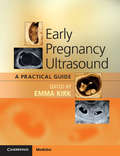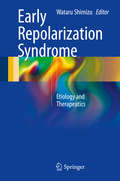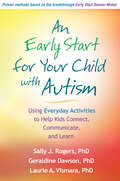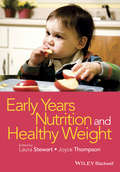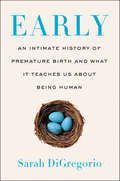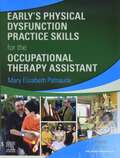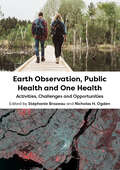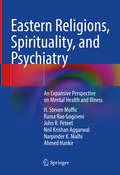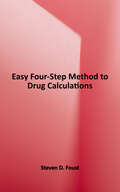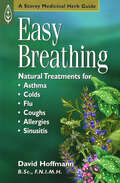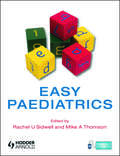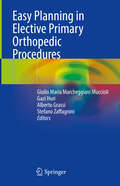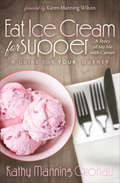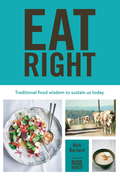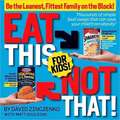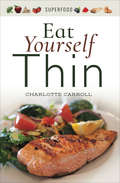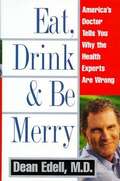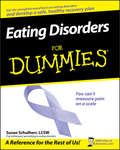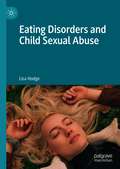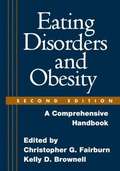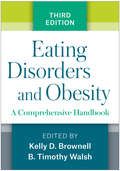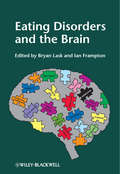- Table View
- List View
Early Pregnancy Ultrasound: A Practical Guide
by Kirk EmmaEarly Pregnancy Ultrasound is a comprehensive and hands-on practical guide that is essential for all health professionals working in the field of early pregnancy. It is highly illustrated with ultrasound images of normal and abnormal pregnancies. It demonstrates how ultrasound can be used to identify and manage complications in early pregnancy. As well as sample ultrasound scan images, the text includes annotated schematic diagrams, tables, flow diagrams, and lists of key learning points - making it an easily accessible learning tool. Early Pregnancy Ultrasound is a key resource for obstetricians, gynaecologists, midwives, nurses and sonographers. It is also an essential text for medical trainees undertaking the Royal College of Obstetricians and Gynaecologists (RCOG) Advanced Training Module in Early Pregnancy, or any trainee interested in early pregnancy.
Early Repolarization Syndrome
by Wataru ShimizuThis book presents the latest findings on early repolarization syndrome (ERS). Readers will find essential information on ERS with regard to its etiology, epidemiology, clinical diagnosis and manifestation, genetic background, and risk stratification, as well as the relationship between ERS and Brugada syndrome. Further chapters discuss pharmacological and non-pharmacological therapies. Early repolarization (ER) pattern or J wave in the inferior and /or lateral leads was initially considered to be a benign electrocardiographic pattern and is often found in healthy young individuals. However, it was reported that ER or J wave was more frequently recognized in patients with idiopathic ventricular fibrillation (IVF) than in control subjects, and that there is a higher incidence of recurrent VF in case subjects with ER or J wave than in those without. This is the early repolarization syndrome or ERS, the theme of this contributed volume. ERS is diagnosed in patients with ER pattern or J wave in the inferior and /or lateral leads of the standard 12-lead electrocardiogram (ECG), who have been resuscitated from IVF. ERS is a relatively a new clinical entity in the field. This much-awaited contributed volume is one of the first references available in the market, an ideal resource for all cardiologists and electrophysiologists working on ERS and related topics.
Early Start for Your Child with Autism
by Geraldine Dawson Sally J. RogersCutting-edge research reveals that parents can play a huge role in helping toddlers and preschoolers with autism spectrum disorders (ASD) connect with others and live up to their potential. This encouraging guide from the developers of a groundbreaking early intervention program provides doable, practical strategies you can use every day. Nearly all young kids-including those with ASD-have an amazing capacity to learn. Drs. Sally Rogers, Geraldine Dawson, and Laurie Vismara make it surprisingly simple to turn daily routines like breakfast or bath time into fun and rewarding learning experiences that target crucial developmental skills. Vivid examples illustrate proven techniques for promoting play, language, and engagement. Get an early start-and give your child the tools to explore and enjoy the world.
Early Trauma as the Origin of Chronic Inflammation: A Psychoneuroimmunological Perspective
by Rainer H. StraubThe aim of the book is to sensitize physicians and researchers to the important long-term health effects of early, persistent, and severe trauma. The author, an internist, rheumatologist, and basic researcher in psychoneuroimmunology, shows connections between adverse childhood experiences and typical adult sequelae. After early traumatic experiences and childhood stress, there is a higher incidence of mental illness, chronic pain, sleep disorders, dental problems, obesity, cardiovascular disease, asthma, diabetes mellitus and chronic inflammation. A selection of diseases unmistakably demonstrate the long-term consequences of early childhood trauma. These childhood experiences create a kind of long-term programming that has a negative effect in adulthood. From his psychoneuroimmunological perspective, Rainer Straub identifies four factors that link the brain to the immune system and are involved in chronic immune activation: direct connectors originating from the brain, indirect connectors functioning through hormonal and neuronal pathways, extracorporeal (the environmental factors) and pleiotropic connectors (genetic factors).
Early Years Nutrition and Healthy Weight
by Joyce Thompson Laura StewartEarly Years Nutrition and Healthy Weight focuses on the early years of childhood as a key period in which eating and exercise habits are formed. Combining current evidence with practical advice, an international group of health specialists advise on the avoidance and management of childhood obesity. They look at key risk areas such as early sedentary behaviour, parental influences and underlying medical causes, and also investigate practical interventions including advice during pregnancy, parenting strategies, and prevention during pre-school and the early school years.This practical handbook contains vital information and advice for all nutritionists and dietitians working with young children and families. It will also be a valuable text for health visitors, paediatricians and general practitioners, and students of nutrition and dietetics specialising in paediatric nutrition.Key features: Only practitioner handbook dedicated to the early years of childhood as the key to ensuring healthy weight in later lifeCovers pregnancy through to pre-school and early school years interventionsAlso addresses the social and psychological issues that underpin nutritional problemsInternational group of expert authors consider the issue across the developed worldCase studies in each chapter illustrate the application of theory to practice
Early-life Environmental Exposure and Disease: Facts and Perspectives
by Yankai XiaThis book offers valuable insights into the latest concepts and findings from epidemiologic, clinical and basic studies in the burgeoning area of early-life environmental exposure and diseases. The book is divided into five parts, starting with an overview of environmental exposure measurement and evaluation, followed by a review of the effects of exposure to various substances like tobacco smoke, pesticides and metals as well as stress on offspring’s health. It then discusses the developmental origins of a range of childhood diseases that affect growth, neural development and the immune system, and highlights the importance of longitudinal studies that measure exposure at potentially sensitive time points during childhood. It also provides up-to-date evidence of the intergenerational/transgenerational effects of early-life environmental exposure, especially via genetic and epigenetic pathways. Allowing readers to gain a thorough understanding of the predominating aspects of early-life environmental exposure and diseases, the book also provides a basis for developing environmental and health policies that could have wide and long-term impacts on human health.
Early: An Intimate History of Premature Birth and What It Teaches Us About Being Human
by Sarah DiGregorio“Sarah DiGregorio delves deeply into the fraught world of premature birth. With bracing honesty, she recounts her own story and the stories of other women who draw on the power of love and meld it with cutting-edge science, as they struggle to save the lives of their newborns. This book opens our minds and hearts to a world that is rarely seen with such clarity.”—Jerome Groopman, MD, Recanati Professor at Harvard Medical School and author of The Anatomy of HopeInspired by the author’s harrowing experience giving birth to her premature daughter, a compelling and empathetic work that combines memoir with rigorous reporting to tell the story of neonatology—and to meditate on the questions raised by premature birth. The heart of many hospitals is the Neonatal Intensive Care Unit (NICU). It is a place where humanity, ethics, and science collide in dramatic and deeply personal ways as parents, doctors, and nurses grapple with sometimes unanswerable questions: When does life begin? When and how should life end? And what does it mean to be human?Nearly twenty years ago, Dr. John D. Lantos wrote The Lazarus Case, a seminal work on ethical dilemmas in neonatology. He described the NICU as “a strong, strange, powerful place.” The NICU is a place made of stories—the stories of mothers and babies who spend days, weeks, and even months waiting to go home, and the dedicated clinicians who care for these tiny, developing humans. The book explores the evolution of neonatology and its breakthroughs—how modern medicine can be successful at saving infants at five and a half months gestation who weigh less than a pound, when only a few decades ago, there were essentially no treatments for premature babies.For the first time, Sarah DiGregorio tells the complete story of this science—and the many people it has touched. Weaving her own story, those of other parents, and NICU clinicians with deeply researched reporting, Early delves deep into the history and future of neonatology, one of the most boundary pushing medical disciplines: how it came to be, how it is evolving, and the political, cultural, and ethical issues that continue to arise in the face of dramatic scientific developments. Eye-opening and vital, Early uses premature birth as a lens to view our own humanity, and the humanity of those around us.
Early’s Physical Dysfunction Practice Skills for the Occupational Therapy
by Mary Elizabeth PatnaudeMaster the role and skills of the OTA in caring for adults with physical disabilities! Early’s Physical Dysfunction Practice Skills for the Occupational Therapy Assistant, 4th Edition is the only textbook on the rehabilitation process written specifically for OTA students and practitioners.It takes a client-centered approach, following the latest Occupational Therapy Practice Framework in addressing topics such as assessment, intervention principles, and clinical applications. New to this edition is an Intervention Principles for Feeding and Eating chapter plus the latest advances in OT technology. From a team of expert contributors led by Mary Elizabeth Patnaude, this book shows how you can succeed in the OTA role and help clients learn to perform functional tasks.
Earth Observation, Public Health and One Health: Activities, Challenges and Opportunities
by Brazeau Stéphanie Nicholas H. OgdenThis book reviews the contributions of Earth Observation (EO) to public health practices. It examines how EO is being used to understand, track, predict, and manage infectious and chronic diseases, and it provides discussion on the current challenges and the significant development potential of EO to a One Health approach. Its objective is to address a set of questions: How does EO currently assist public health activities? What are the challenges for operational use of EO in public health? What are the opportunities for EO to benefit public health in the near future? This review concentrates on the following priority themes to which EO and geomatics can make important contributions: mosquito-borne and tick-borne diseases; water-borne diseases; air quality and extreme heat effects; and geospatial indicators of vulnerable human populations. EO has also demonstrated potential during the COVID-19 pandemic as an efficient provider of data on rapid environmental and socio-economic changes and impacts. Remotely sensed data are particularly useful for risk modelling and mapping projects to help generate information on occurrence and spatio-temporal trends of disease risk. Similarly, EO can be used to identify risk factors for disease risk or emergence detected in surveillance, and support development of early warning systems. Risk maps enable public health professionals to anticipate and prepare for health threats, and they can support responses to infectious disease epidemics or existing endemic conditions. This book emerged from the collaboration of the Public Health Agency of Canada and the Canadian Space Agency with contributions of international experts. Their findings will be of great value to public health and EO professionals interested in developing and applying geospatial applications in the risk assessment and management of public health issues.
Eastern Religions, Spirituality, and Psychiatry: An Expansive Perspective on Mental Health and Illness
by H. Steven Moffic John R. Peteet Ahmed Hankir Neil Krishan Aggarwal Rama Rao Gogineni Narpinder K. MalhiThis book provides a thorough, comprehensive, and accessible reference for all the major Eastern faith traditions and their intersection with psychiatry. Understanding Eastern religion is of paramount value to all mental health professionals, as there is a growing emphasis on religion and spirituality as a part of clinical cultural competence interventions, predominantly in North America and Europe. Additionally, there is rising membership in Eastern, Asian, and non-Semitic faith traditions in North America and Europe. Hence, more patients and clinicians belong to these non-Western faiths than ever before. The volume is divided into five parts. Part 1 covers general issues, including principles of culture, religion, and spirituality in psychiatry, spirituality across the lifespan, child rearing, practice and faith, and how death and dying is approached in these Eastern traditions. Part 2 covers specific Eastern religions and spiritual traditions, including basic principles and research-based clinical aspects of Hinduism, Buddhism, Sikhism, Taoism, Zoroastrianism, Jainism, as well as Confucian philosophical ideas. Part 3 attempts to apply the importance of cultural humility to perspectives on the Eastern Traditions from Western Psychiatry. These include Christian, Muslim, and Jewish perspectives, not of expertise, but of explorations in learning. Part 4 covers specific social psychiatric perspectives, including the psychiatric harm that can come from caste divisions and cults posing as religions, but closes with a perspective on the Eastern connections to the relatively unknown, but unifying, Omnist perspective. All mental health professionals seeking to expand their understanding of the essential belief systems of various Eastern religions and their connection with mental health will find Eastern Religions, Spirituality, and Psychiatry an invaluable resource.
Easy 4-Step Method to Drug Calculations
by S. D. FoustThis unique work-text has been class-tested by hundreds of students. It makes the difficult concept of drug dosage calculations easy to understand and master by using a simple four-step method that focuses only on the information necessary for learning this skill. The readers are guided through every step of the calculation process with easy-to-understand and follow explanations. This is the perfect resource for paramedics, nurses, students and any other health care professionals who administer medication. Features Include: *Straightforward and easy to read *Hundreds of practice problems that incorporate realistic patient scenarios, protocols, and the latest trends in treatment management. *Final review section *Worked out-answer section clearly shows students every step of the problem-solving process.
Easy Breathing: Natural Treatments for Asthma, Colds, Flu, Coughs, Allergies, and Sinusitis (A\storey Medicinal Herb Guide Ser.)
by David HoffmannTaking deep, nourishing breaths of fresh air shouldn’t be a chore. This easy-to-use reference presents a holistic approach to treating chronic respiratory conditions such as asthma and allergies, as well as shorter-term ailments like bronchitis, hay fever, sinusitis, and the common cold. Noted herbal clinician David Hoffman presents an overview of common respiratory conditions, then details preventative strategies, lifestyle changes, and healing herbal formulas to address each. An A-to-Z directory of the most helpful herbs for the respiratory system includes preparation suggestions and dosage guidelines.
Easy Paediatrics
by Rachel U Sidwell Mike A ThomsonWritten by the same author team as the successful and well-regarded Concise Paediatrics for postgraduates, Easy Paediatrics is a textbook specifically written for medical students.Easy Paediatrics is structured in a systems-based fashion, with additional chapters on subjects such as history and examination, development, genetics, emergencies and su
Easy Planning in Elective Primary Orthopedic Procedures
by Stefano Zaffagnini Gazi Huri Giulio Maria Marcheggiani Muccioli Alberto GrassiThis handy and practical book is intended to guide the reader through a correct pre-operative planning in common elective orthopedic procedures. To this aim, it covers arthroplasties and osteotomies of all primary anatomical districts: shoulder, elbow, hip, knee, and ankle. The core idea of the book is that drastic improvements in surgery’s outcomes could be obtained following few correct rules. Moreover, correct pre-operative planning helps minimize errors and optimize the time spent in the operating room. Dedicated chapters also explain the importance of patient positioning. Both young practicing orthopedics and residents will find this book an excellent practical guide to the subject.
Eat Ice Cream for Supper: A Story of My Life with Cancer: A Guide for Your Journey
by Kathy Manning GronauPersonal reflections and practical help for cancer sufferers and those who love them. After Kathy Manning Gronau lost her beloved husband to cancer—and then received a diagnosis herself—her world was turned upside down. In this memoir and guidebook written with loved ones and caregivers in mind, she shares both the emotional and practical difficulties of the disease, as well as useful advice for coping. Eat Ice Cream for Supper addresses issues ranging from medical treatments to spiritual support. If you know someone with a terminal illness, you will benefit from the guidance, information, personal stories, and many real life examples in this book.
Eat Right
by Nick BarnardNominee - James Beard Award: Best Book, Health and Special Diets This comprehensive guide will show you how to find true nourishment and pleasure in the discovery, preparation and eating of real food and drink. It's not about fashionable dieting or being anxious about food choices, it's about positive eating. Techniques include making your own butter, yogurt, ghee, lard, broth, dairy and water kefir, kombucha, coconut water, kimchi, sauerkraut, sourdough, as well as sprouting grains and activating nuts and seeds. And there are also 100 wholesome recipes that encourage the use of good animal fats, well-fed meat, sprouted grains, local and seasonal produce, which will leave you feeling happy and satisfied. This is an easy book to dip into for advice, inspiration and truly health-giving recipes.
Eat Right: The Complete Guide To Traditional Foods, With 130 Nourishing Recipes And Techniques
by Nick BarnardNominee - James Beard Award: Best Book, Health and Special Diets This comprehensive guide will show you how to find true nourishment and pleasure in the discovery, preparation and eating of real food and drink. It's not about fashionable dieting or being anxious about food choices, it's about positive eating. Techniques include making your own butter, yogurt, ghee, lard, broth, dairy and water kefir, kombucha, coconut water, kimchi, sauerkraut, sourdough, as well as sprouting grains and activating nuts and seeds. And there are also 100 wholesome recipes that encourage the use of good animal fats, well-fed meat, sprouted grains, local and seasonal produce, which will leave you feeling happy and satisfied. This is an easy book to dip into for advice, inspiration and truly health-giving recipes.
Eat This Not That! For Kids!
by David Zinczenko Matt GouldingIt's no secret that children are getting fatter: 17% of this country's youth are overweight or obese, and the number of diabetic children has nearly quadrupled in the past thirty years. Now, to help combat the problem, David Zinczenko, editor-in-chief of Men's Health, and co-author Matt Goulding have created Eat This, Not That! for Kids. This must-have guide for concerned parents offers detailed analysis and nutritional tips on thousands of the most popular food choices for kids. Covering the best and worst options available at the most popular restaurants in the country as well as the healthiest-and most harmful-foods in the supermarket aisles, if kids are eating it, this book is probably analyzing it. Other features include:-Restaurant Report Cards on the best chain restaurants for your kids-Drink This, Not That! for Kids-The 20 Worst Kids' Meals in America-10 Healthy" Foods that Aren't-The 8 Foods You Should Feed Your Kid Every Day"
Eat Yourself Thin (Superfood)
by Charlotte Carroll&“No fad diet or banning of food groups—this is about changing your relationship with food and exercise . . . to help you keep the weight off for good&” (The Sun). Would you set aside time each day for the next week or two if it helped transform your body and life and helped you lose the weight that you want? If so, then read on! Diets come and go but medical advice on what constitutes as a good diet has stayed exactly the same, and this book promotes changing your lifestyle for the better through positive reinforcement about how we view ourselves and food. It includes diets from around the world that influence our own eating habits, healthy lifestyle swaps, the triggers to why we eat, and how to overcome any barriers we are feeling around weight loss. Think fats and carbs are bad for you? Find out how they can actually be part of a healthy balanced diet! With edible flower ice lolly recipes and unique alternate therapies, this book will help each individual achieve their goals. Eat Yourself Thin has been written so that readers feel good about themselves, through changing their mindset and how we think about foods and diets. There are facts, studies, healthy recipes, and personal experiences with plenty of humor thrown in. After all, weight loss can be a struggle with cravings, urges, and stress—and laugher is always the best medicine!
Eat, Drink, and Be Merry: America's Doctor Tells You Why the Health Experts are Wrong
by David Schrieberg Dean EdellRadio talk show host Dr. Dean Edell at his best.
Eating Disorders For Dummies
by Susan SchulherrDo you think that you or someone you love may suffer from and eating disorder? Eating Disorders For Dummies gives you the straight facts you need to make sense of what’s happening inside you and offers a simple step-by-step procedure for developing a safe and health plan for recovery. This practical, reassuring, and gentle guide explains anorexia, bulimia, and binge eating disorder in plain English, as well as other disorders such as bigorexia and compulsive exercising. Informative checklists help you determine whether you are suffering form an eating disorder and, if so, what impact the disorder is having or may soon have on your health. You’ll also get plenty of help in finding the right therapist, evaluating the latest treatments, and learning how to support recovery on a day-by-day basis. Discover how to: Identify eating disorder warning signs Set yourself on a sound and successful path to recovery Recognize companion disorders and addictions Handle anxiety and emotional eating Survive setbacks Approach someone about getting treatment Treat eating disorders in men, children, and the elderly Help a sibling, friend, or partner with and eating disorder Benefit from recovery in ways you never imagined Complete with helpful lists of recovery dos and don’ts, Eating Disorders For Dummies is an immensely important resource for anyone who wants to recover — or help a loved one recover — from one of these disabling conditions and regain a healthy and energetic life.
Eating Disorders and Child Sexual Abuse
by Lisa HodgeThis book takes up the challenge of examining women’s understandings of eating disorders and child sexual abuse away from a framework focused on pathology. The central argument is that women’s distress is an enactment of their engagement with certain discourses and practices, rather than a reaction triggered by child sexual abuse. Guided by a contemporary feminist framework and Mikhail Bakhtin’s sociological linguistics, to substantiate the argument, women’s own poetry and drawings are used as evidence to develop, support and supplement research findings. The book establishes that an eating disorder is ‘an understandable response’ to sexual trauma and shifts the focus away from ‘a damaged personality’. Even more importantly, it demonstrates that women with eating disorders are using their bodies as a form of resistance to express silenced traumas that remain in the silenced female body. This is an active way of making sense of experiences of child sexual abuse.
Eating Disorders and Obesity, Second Edition
by Christopher G. Fairburn Kelly D. BrownellThis unique handbook presents and integrates virtually all that is currently known about eating disorders and obesity in one authoritative, accessible, and eminently practical volume. From leading international authorities, 112 concise chapters encapsulate the latest information on all pertinent topics, from biological, psychological, and social processes associated with risk, to clinical methods for assessment and intervention. Suggestions for further reading at the end of each chapter replace extended references and enhance the practical value and readability of the volume.
Eating Disorders and Obesity, Third Edition: A Comprehensive Handbook
by Kelly D. Brownell B. Timothy WalshAcclaimed for its encyclopedic coverage, this is the only handbook that synthesizes current knowledge and clinical practices in the fields of both eating disorders and obesity. Like the prior editions, the significantly revised third edition features more than 100 concise, focused chapters with lists of key readings in place of extended references. All aspects of eating disorders and obesity are addressed by foremost clinical researchers: classification, causes, consequences, risk factors, and pathophysiology, as well as prevention, treatment, assessment, and diagnosis. New to This Edition *Reflects 15 years of important advances in both fields, including state-of-the-art intervention approaches and a growing focus on how the brain regulates eating behavior. *Dozens of entirely new chapters. *New topics: epigenetics, body weight and neurocognitive function, stress and emotion regulation, the gut microbiome, surgical devices for obesity, food labeling and marketing, and more. *Expanded coverage of prevention and policy.
Eating Disorders and the Brain
by Bryan Lask Ian FramptonWhy is the brain important in eating disorders? This ground-breaking new book describes how increasingly sophisticated neuroscientific approaches are revealing much about the role of the brain in eating disorders. Even more importantly, it discusses how underlying brain abnormalities and dysfunction may contribute to the development and help in the treatment of these serious disorders.Neuropsychological studies show impairments in specific cognitive functions, especially executive and visuo-spatial skills.Neuroimaging studies show structural and functional abnormalities, including cortical atrophy and neural circuit abnormalities, the latter appearing to be playing a major part in the development of anorexia nervosa.Neurochemistry studies show dysregulation within neurotransmitter systems, with effects upon the modulation of feeding, mood, anxiety, neuroendocrine control, metabolic rate, sympathetic tone and temperature.The first chapter, by an eating disorders clinician, explains the importance of a neuroscience perspective for clinicians. This is followed by an overview of the common eating disorders, then chapters on what we know of them from studies of neuroimaging, neuropsychology and neurochemistry. The mysterious phenomenon of body image disturbance is then described and explained from a neuroscience perspective. The next two chapters focus on neuroscience models of eating disorders, the first offering an overview and the second a new and comprehensive explanatory model of anorexia nervosa. The following two chapters offer a clinical perspective, with attention on the implications of a neuroscience perspective for patients and their families, the second providing details of clinical applications of neuroscience understanding. The final chapter looks to the future.This book succinctly reviews current knowledge about all these aspects of eating disorder neuroscience and explores the implications for treatment. It will be of great interest to all clinicians (psychiatrists, psychologists, nurses, dieticians, paediatricians, physicians, physiotherapists) working in eating disorders, as well as to neuroscience researchers.
